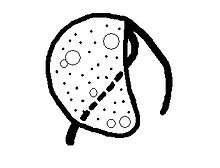Sagenista
| Sagenista | |
|---|---|
 | |
| Cafeteria roenbergensis | |
| Scientific classification | |
| Domain: | Eukaryota |
| (unranked): | SAR |
| Superphylum: | Heterokonta |
| (unranked): | Sagenista Cavalier- Smith, 1995[1] stat. n. 2006 |
| Groups | |
| |

Sagenista is a group of heterokonts which at one time contained the bicosoecids[2] and the slime nets Labyrinthulids.[3] However at present the bicosoecids have been removed in order to make the group monophyletic, also a new group (class Eogyrea) of as yet uncultured protists were added as sister to the Labyrinthulids.[4][5]
It has a special organelle called a Bothrosome. It is usually found in a marine environments rich in algae and sea grass. It is capable of movement by use of this organelle.
They are generally decomposers.
Bothrosome
They are capable of excreting an extoplasmic net of filaments for cells to glide upon. These tiny filaments provide a network for cells to travel upon to soak up nutrients from the surrounding environment.
Uses of Sagenista and Labyrinthulomycota
They are cultivated for their active production of Omega-3 fatty acids. These acids are used as an approved additive for animal feed.
Genera
- Labyrinthula: Possesses a bothrosome. It is being studied for its pathogenic nature in marine environments. It has killed an entire species of Sea grass as well as some species, such as a particular snail that relies on the grass.
- Caecitellus
- Roughly spyhrical,
- Only 2–7 meters (6.5-23') in diameter,
- Has two flagellum,
- Glide on filaments produced by bothrosome,
- The two flagella provide a wrap around the organism to form a sort of exoskeleton,
- Cafeteria. Planktonic species which has only been found in salt water. The two flagellum propel the cell. Reproduce asexually through binary division. Feed on bacteria and small Eukaryotes.
Other information
Until recently Sagenista was labeled as a fungus. It produces asexually and sexually through the use of spores.
There is a debate about whether some species of Sagenista contains a photosynthetic pigment labeled chlorophyll C.
References
- ↑ Cavalier-Smith, T. (1995). Membrane heredity, symbiogenesis, and the multiple origins of algae. In: Arai, R., Kato, M., Doi, Y. (eds). Biodiversity and evolution. The National Science Museum Foundation. Tokyo, pp 75-114.
- ↑ "Browse taxonomic tree". Catalogue of Life : 2008 Annual Checklist.
- ↑ Sandra L. BALDAUF (2008). "An overview of the phylogeny and diversity of eukaryotes" (PDF). Journal of Systematics and Evolution. 46 (3): 263–273. doi:10.3724/SP.J.1002.2008.08060 (inactive 2015-01-09).
- ↑ Cavalier-Smith, T.; Chao, Ema E.-Y. (2006). "Phylogeny and megasystematics of phagotrophic heterokonts (kingdom Chromista)". Journal of Molecular Evolution. pp. 388–420. doi:10.1007/s00239-004-0353-8. PMID 16557340.
- ↑ Cavalier-Smith, T; Scoble, J. M. (2013). "Phylogeny of Heterokonta: Incisomonas marina, a uniciliate gliding opalozoan related to Solenicola (Nanomonadea), and evidence that Actinophryida evolved from raphidophytes". European Journal of Protistology. pp. 328–353. doi:10.1016/j.ejop.2012.09.002.
Bibliography
- Gelenter, Wendy, and Stowell, Larry J. "Progress in understanding rapid blight of cool-season turf." PACE Turfgrass Research Institute Public Edition 9 (2003): 1-4.
- General Mycology. Dept. of Plant Biology, Washington State University.
- Introduction to the Sagenista. Museum of Paleontology, UC-Berkeley.
- Labyrinthulomycetes
- Labyrinthulomycota. Department of Plant Biology, University of Georgia.
- Ralph, Peter J., and Short, Frederick T. "Impact of the wasting disease pathogen, Labyrinthula zosterae, on the photobiology of Zostera marina." Marine Ecology Progress Series 226 (2002): 265-271.
- Regan, Casie. Vampire Scientists Study Sea Grass Slime Mold in Florida Bay. National Park Service.